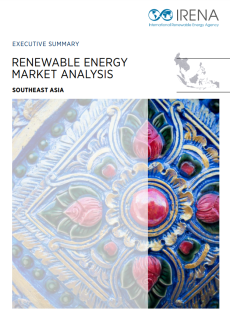
The International Renewable Energy Agency (IRENA) Renewable Energy Market Analysis series captures the wealth of knowledge and experience embedded in different regions. It identifies emerging trends and themes at the intersection of public policy and market development. The first two editions covered the Gulf Cooperation Council (GCC) countries (2015) and Latin America (2016).
This edition focuses on Southeast Asia, a region characterised by strong economic growth, rising energy demand, growing environmental challenges and concerns about energy security. The countries analysed are the Members States of the Association of Southeast Asian Nations (ASEAN): Brunei Darussalam, Cambodia, Indonesia, the Lao People’s Democratic Republic (Lao PDR), Malaysia, Myanmar, the Philippines, Singapore, Thailand and Viet Nam.
Findings include:
- Energy underpins future growth and supports the region’s progress toward key development goals. Chapter 1 describes macroeconomic and social trends, examining the relationship between economic growth and energy demand.
- The region relies heavily on fossil fuels, both for power generation and transportation. Yet some 65 million people in the region (as of 2017-2018) lack adequate or reliable electricity access. Chapter 2 analyses the regional energy landscape as countries strive to diversify with more renewables.
- Southeast Asia’s rich renewable energy potential remains largely untapped. Chapter 3 analyses the latest cost and deployment trends as well as economic and job benefits offered by renewables.
- The 10-member Association of Southeast Asian Nations (ASEAN) has agreed on a 23% target for sustainable, modern renewables by 2025. Chapter 4highlights regional and national targets and examines the policy and institutional frameworks for scaling up renewables across the region.
- Between 2006 and 2016, cumulative investment in renewable energy in Souteast Asia amounted to USD 27 billion. Chapter 5 analyses the latest investment trends, the evolution of the capital mix, and measures to address remaining finance barriers.
- Southeast Asia offers compelling examples of the synergies between renewable energy and socio-economic development, whether in rural, urban or island settings. Chapter 6 highlights the wide-ranging benefits of decentralised renewable energy solutions, particularly as the region strives to meet United Nations Sustainable Development Goals.
